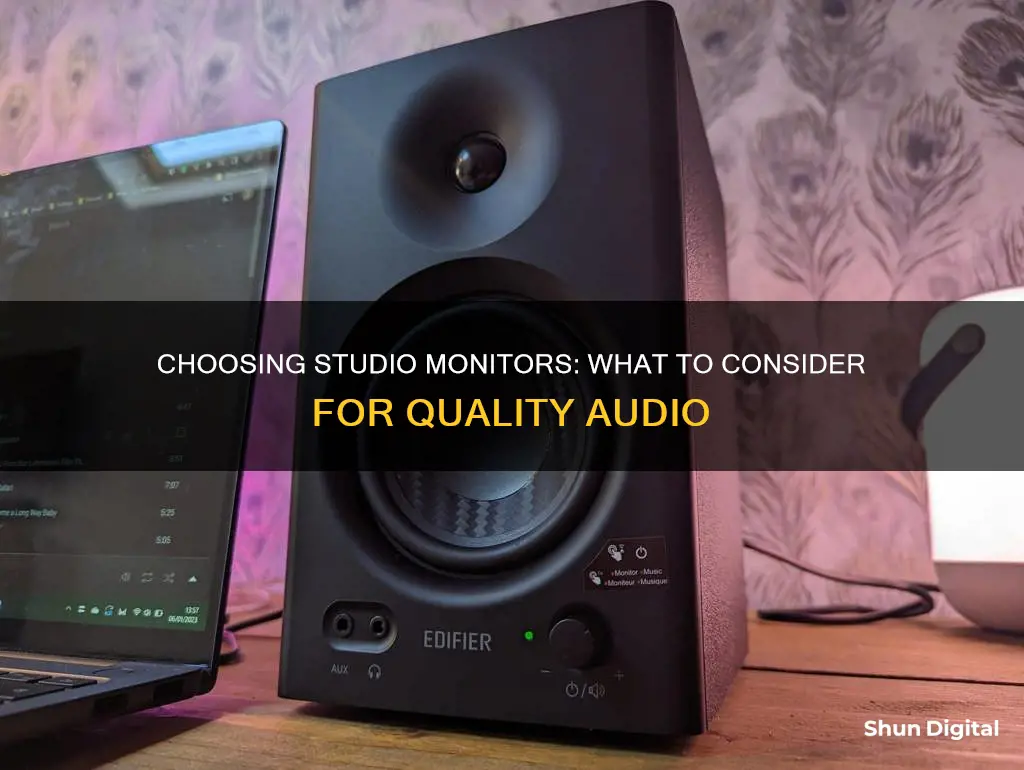
Studio monitors are an essential component of any studio setup, allowing producers and mixers to hear their music accurately and make informed decisions during the recording, mixing, and mastering process. When evaluating studio monitors, it is crucial to consider various factors to ensure optimal sound quality and performance. Here are some key aspects to keep in mind:
- Room Size and Treatment: The size and acoustics of your room play a significant role in choosing the right studio monitors. Smaller rooms may require near-field monitors with front-firing bass ports to reduce back-wall resonances, while larger spaces may need mid-field monitors for adequate power and low-end response. Acoustic treatment, such as bass traps, diffusers, and panels, is essential to optimise the sound and minimise reflections and standing waves.
- Frequency Response: Look for monitors with a flat frequency response, ensuring that all frequencies are reproduced accurately and without emphasis on any particular part of the spectrum. The frequency response can be affected by room acoustics, so proper treatment is crucial.
- Active vs. Passive Monitors: Active monitors have built-in amplifiers, making them a popular choice for their ease of use and compatibility with the speakers. Passive monitors, on the other hand, require external amplifiers, offering more flexibility in amplifier selection.
- Two-Way vs. Three-Way Monitors: Two-way monitors feature a tweeter for high frequencies and a woofer for mid-range and low frequencies, making them an affordable and straightforward option. Three-way monitors add a dedicated mid-range driver, enhancing clarity and providing better insights into your audio.
- Digital vs. Analogue Monitors: While analogue monitors dominated the market for most of the 20th century, digital monitors with Digital Signal Processors (DSP) have gained popularity. Both options have their pros and cons, and the choice depends on personal preference and specific needs.
- Testing and Comparison: When evaluating monitors, pay attention to their position, level, and the type of music used for testing. Ensure they are placed equidistant from each other, and adjust the gain to maintain the same subjective loudness across different tracks. Acoustic recordings with natural instruments and voices can help judge the authenticity of the reproduction.
| Characteristics | Values |
|---|---|
| Placement | Monitors should be placed equidistant from the listener, with the back of the speakers no more than 60cm from the wall. |
| Room Size | Smaller rooms require smaller monitors, while larger rooms need larger monitors. |
| Room Treatment | Acoustic treatment is important to optimise sound. |
| Frequency Response | Monitors should have a flat frequency response. |
| Active vs Passive | Active monitors are self-powered, while passive monitors require external amplifiers. |
| Two-Way vs Three-Way | Two-way monitors have a woofer and tweeter, while three-way monitors add a mid-range driver. |
| Digital vs Analogue | Digital monitors use DSPs, while analogue monitors do not. |
| Testing | Testing and comparing monitors is important. Pay attention to placement, level, and music choice. |
What You'll Learn

Room size and treatment
The size of your room and its treatment are crucial factors when evaluating studio monitors. The placement of monitors will depend on your room, and you may need to angle them if you have a longer wall. It is generally better to have a larger gap between the front wall and the monitors, but in smaller spaces, it may be preferable to have them closer to the wall.
To get the best sound from your monitors, treat and tune your room. Acoustic treatment can help to minimise sound reflections and improve the accuracy of your monitors. This can be done by adding foam panels to the walls and ceiling, and ensuring the room is well-sealed to prevent sound leakage. The ideal room for studio monitors is a rectangular, windowless room with a high ceiling. However, not everyone has access to such a space, so treatment is key to getting the most out of your monitors in a less-than-ideal room.
Monitor placement is also key, and you may need to experiment with different positions to find the optimal setup for your room. A common guideline is to form an equilateral triangle between your monitors and your head when sitting in your usual listening position. This can help ensure you are in the 'sweet spot' for the best sound.
Cleaning Monitors: Safely Removing Stains and Smudges from Your Screen
You may want to see also

Active vs. passive monitors
When it comes to studio monitors, you have the option of choosing between active and passive monitors. So, what's the difference between the two, and which one should you go for? Let's dive into the details and find out!
Active Monitors
Active monitors are designed for convenience and ease of use. They have built-in amplifiers, which means you won't need any external equipment to get them up and running. This plug-and-play feature makes active monitors a popular choice, especially for those who want a simple and reliable setup. The amplifiers in active monitors are specifically designed and tuned for the monitors, often resulting in better overall sound quality. Additionally, active monitors offer benefits such as optimised driver-protection circuitry and short, direct connections between amplifiers and drivers.
Passive Monitors
Passive monitors, on the other hand, require external amplifiers to function. This separation of components provides passive monitors with an advantage in terms of flexibility and upgradability. With passive monitors, you can choose an external amplifier that perfectly matches your monitors' power rating and impedance, ensuring optimal performance. The ability to upgrade the speakers and amplifiers separately allows for a more gradual and cost-effective progression to higher-quality gear. However, the downside is that passive monitors may require more effort and time for setup and optimisation.
Making the Choice
The decision between active and passive monitors ultimately depends on your specific needs and preferences. If you prioritise simplicity, convenience, and a reliable all-in-one solution, active monitors are the way to go. On the other hand, if flexibility and upgradability are more important to you, passive monitors might be a better fit. It's worth noting that while active monitors are more common in professional studios, countless professionals also rely on passive monitoring systems, demonstrating that both options can deliver excellent results.
Ankle Monitors: Effective Surveillance or Easy to Cheat?
You may want to see also

Two-way vs. three-way
When it comes to studio monitors, the terms 'two-way' and 'three-way' refer to how many times the audio frequency band is split by the crossover, rather than the number of drive units within each speaker. A two-way speaker system divides the audio frequency band into two parts, which are handled by two types of drivers: tweeters and woofers, which deal with high and mid to low frequencies, respectively. On the other hand, a three-way speaker system splits the audio band into three parts, using three types of drivers: tweeters, midrange drivers, and woofers, which handle high, mid, and low frequencies, respectively.
The main difference between two-way and three-way speakers is the number of crossover points. Three-way speakers tend to offer a broader frequency range with better bass extension, while two-way speakers are more power-efficient and cost-effective. Three-way speakers generally deliver a fuller and more accurate sound, with greater mid-range definition, leading to improved clarity and nuance in vocal performances. However, they can sometimes sound more disjointed due to the blending of different frequency types. Two-way speakers, despite having fewer drivers, can still provide excellent detail and are often preferred due to their portability and compact design.
When deciding between two-way and three-way studio monitors, it is essential to consider your specific needs and budget. Two-way speakers are ideal for those on a budget or with limited space, as they are generally more affordable and smaller in size. They are also suitable for everyday use, such as listening to music or creating rough mixes. Three-way speakers, on the other hand, are recommended for professionals or serious audio enthusiasts who require the highest level of detail and accuracy in their mixes. They are typically more expensive and may require a more powerful amplifier to operate.
Ultimately, the choice between two-way and three-way studio monitors depends on your individual preferences, budget, and audio setup. While three-way speakers offer a broader frequency range and enhanced detail, some listeners prefer two-way speakers for their simpler design and smoother transition between frequency ranges.
Removing Ankle GPS Monitors: A Step-by-Step Guide
You may want to see also

Digital vs. analogue
When it comes to studio monitors, there are two types of inputs: analogue and digital. So, which is better?
Analogue Input
Analogue input is the most common type of input used in studios. It involves using balanced analogue cables, such as TRS (guitar cables) or XLR cables, to connect the monitors to the audio interface. Analogue input is known for its simplicity and reliability, and it is the standard choice for most studios.
Digital Input
Digital input, on the other hand, uses digital cables such as AES/EBU to connect the monitors to the audio interface. Digital input offers a cleaner signal by bypassing one DA-AD conversion loop. However, not all monitors support digital input, and it may require additional investments in converters and cables.
The answer depends on your specific setup and preferences. If your monitors support digital input and you have the necessary cables and converters, then digital input is generally the better choice as it provides a cleaner signal. However, if you have a high-quality D/A converter, the difference between analogue and digital input may not be noticeable. Ultimately, the best way to decide is to listen to both options and pick the one that sounds better to you.
Setting Primary Monitor in Windows 10: A Simple Guide
You may want to see also

How to test monitors
Testing and comparing monitors is a great way to make a final decision. Here are some tips to keep in mind when testing:
- Positioning: Place the monitors equidistant from each other, but not symmetrically.
- Levels: Pay careful attention to subjective listening levels. Due to differences in the frequency response between monitor designs, you may need to change the gain of the monitors to ensure you're comparing them at the same subjective loudness.
- Music: Listen to acoustic recordings with natural instruments and voices. This will allow you to judge how authentic the recordings sound, rather than being impressed by powerful bass response.
- Flat filters: Set all filters in the monitors to a flat response initially. This will reveal the intended character of the speaker. If you feel a monitor sounds too bright, for example, apply a shelf filter and repeat the listening test with the same tracks.
- Recordings: Listen to known recordings to help minimise unknown parameters in a comparative listening test and help you focus on the evaluation. Recordings known for their overall quality will help reveal differences between monitors much more easily.
Remember, the only meaningful way to evaluate monitors is to mix on them. This will depend on your own circumstances. If you're buying used monitors, this may not be practical.
LCD Monitor Burn-In: Is It Still an Issue?
You may want to see also
Frequently asked questions
The size and shape of your room, the type of music you produce, and whether you need portability or a fixed setup are all important factors. Additionally, the size of your room will dictate the size of your monitors, with smaller rooms requiring smaller monitors to avoid muddled sound.
Active monitors have built-in amplifiers, making them simpler to use and ideal for audio production. Passive monitors, on the other hand, require external amplifiers and offer more flexibility.
Place your monitors equidistant from the walls and your mixing spot, ensuring the back of the monitors is at least 5cm away from the wall. The recommended distance between the centre of each monitor and your listening position should form an equilateral triangle.
For beginners, a range of 50-75 watts per channel is a good starting point. More powerful monitors, with 100 watts or more per channel, may be needed for larger commercial studios.
For your first set of monitors, $200-$400 is a reasonable range. As you progress, you can expect to spend $400-$1,000, and professional-grade monitors can cost upwards of $1,000 per monitor.







